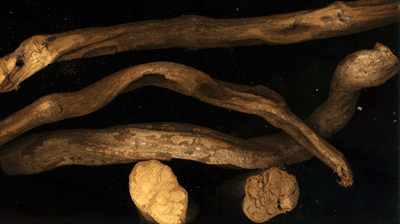
Shamanic Understanding:
"What is fascinating to consider is how these early shamans figured out that a potent brew could best be made from these two ingredients being mixed together."
ayauhasca.us
In the last few years another South American entheogen ayahuasca has received a lot of attention in the West. While ayahuasca has been known to anthropologists for most of the last century, correct identification of the plants and some understanding or the complex chemistry involved has only been achieved in the last twenty years.
A great deal of confusion remains, facilitated by the fact that the varieties of ayahuasca or anahuasca are many. Furthermore, botanical identification of all the Ayahuasca is so very deeply rooted and pervasive across most of the Amazonian societies that it must have a very ancient history. The names are many --- yage, yaje, huasca, and caapi among numerous others. Ayahuasca is most often made from at least two plants – a vine called Banisteriopsis caapi and another tryptamine-filled plant.


Diplopterys cabrerana leaves tied together ready to brew.
Pronounced /aɪjəˈwæskə/ ... click to listen
B. caapi by itself is also called ayahuasca, which translates as the “vine of the soul.” Adding to the confusion, ayahuasca is occasionally made from only the vine and for a long time scientists thought that the vine provided the only psychoactive ingredient harmaline and harmine. But ayahuasca is generally made from both B. caapi and either psychotria viridis, in the southern reaches of South America, or Diplopterys cabrerana or “chacruna” from the northern regions. Both are rich in tryptamines. Nonetheless to date more than several hundred plants has been identified as additives to the yage brew. When yage is made from the vine alone mild psycho activity is obtained. But things get considerably more exciting when at least one tryptamine-laden plant is added. As harmine and harmaline are excellent monoamine oxidase inhibitors, the tryptamines which otherwise are metabolized in the human stomach become psychoactive.
What is fascinating to consider is how these early shamans figured out that a potent brew could best be made from these two ingredients being mixed together, as consuming a tryptamine-filled plant without an effective MAOI gives one no psychedelic effect at all.
The brew is prepared by boiling the admixtures together for hours (today a pressure cooker is often used) and then drinking the resulting thick alkaloid-tasting liquid. Ayahuasca is nicknamed “la purga” for a reason, as nausea and vomiting are quite common. The effects are strong and last about two hours, with intense visions often filled with jungle themes, jaguars and (anaconda) snakes. Sessions often involve the repeated drinking of material so that they can be all night affairs.
Like peyote, ayahuasca has been at the center of new synchretic Christian-Amerindian religions as expressed by the Udiao de Vegetal and Santo Daime churches, active most notable in Brazil but spreading rapidly worldwide. These are churches with a capital "C." Ayahuasca is one of the few entheogens to be international recognized as a psychedelic sacrament and to be considered a protected patent.